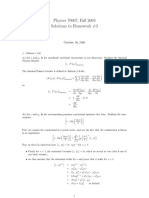Introduction To Green's Functions
Uploaded by
Elvis ArguellesIntroduction To Green's Functions
Uploaded by
Elvis ArguellesIntroduction to Greens
Functions
Elvis F. Arguelles
Physics Department, DLSU
Greens Functions Definition
Greens Functions are often defined as a solution
to inhomogeneous Sturm Liouville differential
equation of the form:
Where satisfies (1) and obeys the boundary
condition at the interval , and is
any linear, Hermitian operator.
We define a function that satisfies the differential
equation:
) ( ) (
x f x L = |
(1)
) (x |
L
b x a s s
( ) x x x x G L
'
=
'
o ) , (
(2)
Greens Function Intro
If we can determine the function , we can
immediately write the solution/s to (1) as
We call the Greens Function.
It is straightforward to see that (3) satisfies (1) by
substituting it in (1)
}
' ' '
= x d x f x x G x ) ( ) , ( ) ( |
) , ( x x G
'
(3)
}
' ' '
= = x d x f x x G L x f x L ) ( ) , (
) ( ) (
|
) ( ) ( ) ( ) ( x f x d x f x x x f
'
=
' ' '
=
}
o
) , ( x x G
'
Example: Electric Potential
An example of the use of GF is in solving the
electrostatic potential given by the Poisson
equation:
Equation (4) is in the same form as (1) with
and
We can immediately define our GF by:
And our potential is given by (3):
0
2
) (
) (
c
x
x = u V
(4)
2
V L
) ( ) ( x x f
) ( ) , (
2
x x x x G
'
=
'
V o
x d
x
x x G x
'
'
'
= u
}
3
0
) (
) , ( ) (
c
(5)
Example: Electric Potential
To prove (5), we recall Greens theorem. We define two
functions A and B:
Then we use Divergence theorem:
We substitute A in (6) and we have
Using vector identity, we can express the LHS of (7) as
( ) x d A da n A
V s
3
} }
V =
V = A
( ) ( ) x d da n
V S
} }
V V = V
3
( ) ( ) ( )
( ) ( ) ( )
} } }
} } }
V V + V = V V
V V + V V = V V
V V V
V V V
x d x d x d
x d x d x d
3 3 2 3
3 3 3
(6)
V = B
(7)
Example: Electric Potential
Equation (7) now takes the form
We do the same thing with B we have:
With
We subtract (9) from (8)
This is Greens theorem. Take note that the last terms of (8)
and (9) cancel out each other
n
n
c
+ c
= + V
( ) ( )
} } }
V V + V =
|
.
|
\
|
c
c
V V S
x d x d da
n
3 3 2
( ) x d da
n n
v s
3 2 2
} }
V V =
|
.
|
\
|
c
c
c
c
(8)
(9)
( ) ( )
} } }
V V + V =
|
.
|
\
|
c
c
V V S
x d x d da
n
3 3 2
(10)
Example: Electric Potential
From Greens theorem (10), we replace with
In (11), if we make the volume V which the surface S encloses,
the integral on the LHS of (11) vanishes for large V as S explodes.
From the definition of the GF,
( ) x d G G x d
n
G
n
G
v v
3 2 2 3
} }
V V =
|
.
|
\
|
c
c
c
c
(11)
(12)
G
( )
( ) ( )
} }
}
V = V
= V V
v v
v
x d G x d G
x d G G
3 2 3 2
3 2 2
0
( ) ( )
( )
}
} }
V =
V =
'
v
v v
x d G
x d G x d x x
3 2
3 2 3
o
(13)
Example: Electric Potential
If we take
Eq. (12) becomes
Which consequently proves (5). Our next problem
then is find an expression for our GF. From vector
analysis, we have
We manipulate (14) a bit more we have
Its easy to see that
) (x u
(13)
(14)
(15)
( ) x d
x
x x G x d G
v v
'
'
'
= u V = u =
} }
3
0
3 2
) (
) , (
c
) ( 4
1
2
x x
x x
'
=
|
|
.
|
\
|
'
V
to
) (
4
1
2
x x
x x
' =
|
|
.
|
\
|
'
V
o
t
x x
x x G
'
= '
t 4
1
) , (
Example: Electric Potential
The electric potential now takes the familiar form
(16)
x d
x x
x
x
x d
x
x x G x
v
v
'
'
'
= u
'
'
'
= u
}
}
3
0
3
0
4
) (
) (
) (
) , ( ) (
tc
Greens Function in Quantum
Mechanics
GF can also be considered as solution to
inhomogeneous differential equation
Here, we have
is the usual time independent, Hermitian, linear
differential operator with complete set of
eigenfunctions.
| | ) ( ) ; , ( ) (
x x z x x G x L z
'
=
'
o
17
{ }
{ } z s
z
is z
Im
Re
+ =
) (
x L
GF in QM
We can express the operator using the eigenvalue
equation
The set satisfy the BC as the GF and
considered orthonormal
With the assumption that the set is complete we can
expand the delta function using infinite series
) ( ) ( ) (
x x x L
n n n
| | =
nm n m
x d x x o | | =
}
-
) ( ) (
{ } ) (x
n
|
=
'
n
n n
x a x x ) ( ) (
| o
18
19
20
GF in QM
We multiply both sides by and integrate over
x we get
And the Dirac delta function can now be written as
In Dirac notation,
) ( ) ( ) (
*
x x x x
n
n
n
| | o
'
=
'
) (x
m
'
-
|
nm
n
n m
n
n m n m
a x
x d x x a x d x x x
o |
| | | o
} }
=
'
' '
=
' ' '
-
- -
) (
) ( ) ( ) ( ) (
21
x z G x z x x G
x L x x L x x
'
=
'
'
=
'
) ( ) ; , (
) (
) ( o
22
23
GF in QM
With
In this notation we can write
) (
1
x x x x
dx x x
'
=
'
=
}
o
( ) 1 ) (
1
=
=
=
=
z G L z
L
n
n n
nm m n
n n n
| |
o | |
| |
24
25
26
27
28
29
We take the matrix elements of (29) we have
And therefore
We as we can see, is just similar to (17)
( )
( ) ) ( ) (
1 ) (
x x x z G L z x
x x x x x z G L z x
'
=
'
'
=
'
=
'
o
( )
( )
( )
( )
( )
( )
| |
| | ) ( ) ; , ( ) (
) ; , ( ) ( ) ; , ( ) ( ) ; , (
) ( ) ; , ( ) ( ) ; , ( ) (
) ; , ( ) ( ) ( ) ; , ( ) (
) ( ) ; , ( ) (
) ( ) ; , ( ) (
) ( ) ; , ( ) (
) ( ) ( ) (
x x z x x G x L z
z x x G x L z z x x G x L z x x zG
x x z x x G x L z x x zG x z G L z x
z x x G x x x L x d z x x zG x z G L z x
x z G x x L x x d z x x zG x z G L z x
x z LG x x x x d z x x zG x z G L z x
x z LG x z x x zG x z G L z x
x z LG x x z G x z x z G L z x
'
=
'
'
=
'
'
'
=
'
'
=
'
' ' ' ' '
' '
'
=
'
' ' ' ' ' ' '
'
=
'
' ' ' ' ' ' '
'
=
'
'
'
=
'
'
'
=
'
}
}
}
o
o
o
If the eigenvalues of exist,
We can write (29) as
We multiply (30) by (28) we have
We recall that
Therefore
L z
n
z =
L z
z G
=
1
) ( 30
n n
n
n
n n
n
n
n
n
z
z G
L z L z
z G
| |
| | | |
=
1
) (
1 1
) (
}
+
'
= dn
n n
n
n n
n
n
z
dn
z
z G | |
| |
+
=
}
1 1
) (
'
31
32
33
In the representation we have
From (34), we can immediately see that has simple
poles at the position of the discrete eigenvalues of .
If , where belongs to the continuous eigenvalues of
, is not well defined since the integrand in (34)
has a pole.
We can however define by a limiting procedure.
x
L z
z G
=
1
) (
34
n
n n
n
n
n n
z
x x
dn
z
x x
z x x G
| |
| |
'
+
'
=
'
}
) ( ) ( ) ( ) (
) ; , (
* *
'
) (z G
L
= z
L
) ; , ( z x x G
'
) ; , ( z x x G
'
) ; , ( lim ) ; , (
) ; , ( lim ) ; , (
0
0
is x x G x x G
is x x G x x G
s
s
'
=
'
+
'
=
'
+
From (34) we can also see that
We use the identity
We have
) ; , ( ) ; , (
* *
z x x G z x x G
'
=
'
) (
1 1
lim
0
u i
u
P
iv u
v
to =
) (
) ( ) (
) (
) ( ) (
2
) (
) ( ) (
2
) (
) ( ) ( ) ( ) (
) (
) ( ) ( ) ( ) (
) ; , (
~
) ( ) (
lim
) ( ) (
lim ) ; , (
~
) ; , ( lim ) ; , ( lim ) ; , (
~
) ( ) ( ) (
~
* *
'
*
* *
* *
*
0
*
0
0 0
n
n
n n
n
n
n
n n
n
n
n
n n
n
n
n
n n
n
n
n n
n
n
n
n n
n
n
n n
n
n
n n
s
n
n
n n
s
s s
x x
dn
x x
i
x x
i
x x
i
x x
P
x x
i
x x
P x x G
is
x x
is
x x
x x G
is x x G is x x G x x G
G G G
o
| |
o
| |
t
o
| |
t
o
| |
t
| |
o
| |
t
| |
| |
| |
= '
+
= '
' + ' = '
=
}
You might also like
- Physics 304 Thermodynamics Notes: An Introduction To Thermal Physics, D. V. Schroeder, Addison Wesley Longman, 2000No ratings yetPhysics 304 Thermodynamics Notes: An Introduction To Thermal Physics, D. V. Schroeder, Addison Wesley Longman, 200057 pages
- Statistical Mechanics Bipin K Agarwal Melvin Eisnerpdf CompressNo ratings yetStatistical Mechanics Bipin K Agarwal Melvin Eisnerpdf Compress280 pages
- Greiner W. Thermodynamics and Statistical MechanicsNo ratings yetGreiner W. Thermodynamics and Statistical Mechanics463 pages
- Robert Resnick Introduction To Special R (1) - 3411601103407702No ratings yetRobert Resnick Introduction To Special R (1) - 3411601103407702239 pages
- Constantinescu Magyari-Problems in Quantum Mechanics 1100% (2)Constantinescu Magyari-Problems in Quantum Mechanics 1417 pages
- Quantum Mechanics: A Mathematical IntroductionNo ratings yetQuantum Mechanics: A Mathematical Introduction144 pages
- Theoretical Concepts of Quantum Mechanics PDF100% (1)Theoretical Concepts of Quantum Mechanics PDF610 pages
- J. A. Pople Auth., Henry F. Schaefer III Eds. Applications of Electronic Structure TheoryNo ratings yetJ. A. Pople Auth., Henry F. Schaefer III Eds. Applications of Electronic Structure Theory469 pages
- Lagrangian Mechanics: 3.1 Action PrincipleNo ratings yetLagrangian Mechanics: 3.1 Action Principle15 pages
- Condensed Mattter Physics@Previous Year Questions Topic Wise Solved QuestionsNo ratings yetCondensed Mattter Physics@Previous Year Questions Topic Wise Solved Questions43 pages
- A modern approach to classical mechanics Iro all chapter instant downloadNo ratings yetA modern approach to classical mechanics Iro all chapter instant download55 pages
- Laplace's Equation With Physically Uncommon Boundary Conditions0% (1)Laplace's Equation With Physically Uncommon Boundary Conditions4 pages
- QualifyingExamProblemSolutionsUnivOfILLionisNotesStatisticalMechanics PDFNo ratings yetQualifyingExamProblemSolutionsUnivOfILLionisNotesStatisticalMechanics PDF216 pages
- Introduction To Tensors: Contravariant and Covariant VectorsNo ratings yetIntroduction To Tensors: Contravariant and Covariant Vectors18 pages
- Crystal-Field Theory, Tight-Binding Method, and Jahn-Teller EffectNo ratings yetCrystal-Field Theory, Tight-Binding Method, and Jahn-Teller Effect39 pages
- Partial Differentiation - GATE Study Material in PDFNo ratings yetPartial Differentiation - GATE Study Material in PDF8 pages
- Course Syllabus 1. Course Title Integral Calculus 2. Course DescriptionNo ratings yetCourse Syllabus 1. Course Title Integral Calculus 2. Course Description7 pages
- Sbte Syllabus - 57 - 1st Semester - Electronics - Session 2023-24-1No ratings yetSbte Syllabus - 57 - 1st Semester - Electronics - Session 2023-24-171 pages
- Recitation 11: Based On Nesterov, Yurii. Introductory Lectures On Convex Optimization: A Basic CourseNo ratings yetRecitation 11: Based On Nesterov, Yurii. Introductory Lectures On Convex Optimization: A Basic Course3 pages
- Download Calculus Concepts An Applied Approach to the Mathematics of Change 4th Edition Donald R. Latorre ebook All Chapters PDFNo ratings yetDownload Calculus Concepts An Applied Approach to the Mathematics of Change 4th Edition Donald R. Latorre ebook All Chapters PDF67 pages
- Antiderivatives of Algebraic Functions: Basic Calculus Grade 12 Quarter 4 May, 2021No ratings yetAntiderivatives of Algebraic Functions: Basic Calculus Grade 12 Quarter 4 May, 20213 pages
- Chap10 ENGINEERING APPLICATION (L - Week 14)No ratings yetChap10 ENGINEERING APPLICATION (L - Week 14)12 pages
- Oksendal - Stochastic Differential Equations50% (2)Oksendal - Stochastic Differential Equations385 pages
- Lecture 6 (Inverse Trigonometric Functions)No ratings yetLecture 6 (Inverse Trigonometric Functions)29 pages
- 1.6 Solution of Homogeneous, Linear, Constant-Coefficient OdesNo ratings yet1.6 Solution of Homogeneous, Linear, Constant-Coefficient Odes23 pages
- Implementation of A Complex Fractional Order Proportional-Integral-Derivative Controller For A First Order Plus Dead Time SystemNo ratings yetImplementation of A Complex Fractional Order Proportional-Integral-Derivative Controller For A First Order Plus Dead Time System8 pages
- Advanced Calculus 2nd Edition Patrick M. Fitzpatrick - Download the full ebook now for a seamless reading experience100% (1)Advanced Calculus 2nd Edition Patrick M. Fitzpatrick - Download the full ebook now for a seamless reading experience51 pages
- PDF Complex Variables A Physical Approach with Applications Textbooks in Mathematics 2nd Edition Steven G. Krantz downloadNo ratings yetPDF Complex Variables A Physical Approach with Applications Textbooks in Mathematics 2nd Edition Steven G. Krantz download55 pages
- Stewart, Calculus, Early Transcendentals, P. 549, #28No ratings yetStewart, Calculus, Early Transcendentals, P. 549, #282 pages
- 2019 MA Curve Sketching and Primitive Functions Worksheet HSC Questions W/solutionsNo ratings yet2019 MA Curve Sketching and Primitive Functions Worksheet HSC Questions W/solutions23 pages
- Physics 304 Thermodynamics Notes: An Introduction To Thermal Physics, D. V. Schroeder, Addison Wesley Longman, 2000Physics 304 Thermodynamics Notes: An Introduction To Thermal Physics, D. V. Schroeder, Addison Wesley Longman, 2000
- Statistical Mechanics Bipin K Agarwal Melvin Eisnerpdf CompressStatistical Mechanics Bipin K Agarwal Melvin Eisnerpdf Compress
- Greiner W. Thermodynamics and Statistical MechanicsGreiner W. Thermodynamics and Statistical Mechanics
- Robert Resnick Introduction To Special R (1) - 3411601103407702Robert Resnick Introduction To Special R (1) - 3411601103407702
- Constantinescu Magyari-Problems in Quantum Mechanics 1Constantinescu Magyari-Problems in Quantum Mechanics 1
- J. A. Pople Auth., Henry F. Schaefer III Eds. Applications of Electronic Structure TheoryJ. A. Pople Auth., Henry F. Schaefer III Eds. Applications of Electronic Structure Theory
- Condensed Mattter Physics@Previous Year Questions Topic Wise Solved QuestionsCondensed Mattter Physics@Previous Year Questions Topic Wise Solved Questions
- A modern approach to classical mechanics Iro all chapter instant downloadA modern approach to classical mechanics Iro all chapter instant download
- Laplace's Equation With Physically Uncommon Boundary ConditionsLaplace's Equation With Physically Uncommon Boundary Conditions
- QualifyingExamProblemSolutionsUnivOfILLionisNotesStatisticalMechanics PDFQualifyingExamProblemSolutionsUnivOfILLionisNotesStatisticalMechanics PDF
- Introduction To Tensors: Contravariant and Covariant VectorsIntroduction To Tensors: Contravariant and Covariant Vectors
- Crystal-Field Theory, Tight-Binding Method, and Jahn-Teller EffectCrystal-Field Theory, Tight-Binding Method, and Jahn-Teller Effect
- Balungi's Approach to Quantum Gravity: Beyond Einstein, #5From EverandBalungi's Approach to Quantum Gravity: Beyond Einstein, #5
- Partial Differentiation - GATE Study Material in PDFPartial Differentiation - GATE Study Material in PDF
- Course Syllabus 1. Course Title Integral Calculus 2. Course DescriptionCourse Syllabus 1. Course Title Integral Calculus 2. Course Description
- Sbte Syllabus - 57 - 1st Semester - Electronics - Session 2023-24-1Sbte Syllabus - 57 - 1st Semester - Electronics - Session 2023-24-1
- Recitation 11: Based On Nesterov, Yurii. Introductory Lectures On Convex Optimization: A Basic CourseRecitation 11: Based On Nesterov, Yurii. Introductory Lectures On Convex Optimization: A Basic Course
- Download Calculus Concepts An Applied Approach to the Mathematics of Change 4th Edition Donald R. Latorre ebook All Chapters PDFDownload Calculus Concepts An Applied Approach to the Mathematics of Change 4th Edition Donald R. Latorre ebook All Chapters PDF
- Antiderivatives of Algebraic Functions: Basic Calculus Grade 12 Quarter 4 May, 2021Antiderivatives of Algebraic Functions: Basic Calculus Grade 12 Quarter 4 May, 2021
- 1.6 Solution of Homogeneous, Linear, Constant-Coefficient Odes1.6 Solution of Homogeneous, Linear, Constant-Coefficient Odes
- Implementation of A Complex Fractional Order Proportional-Integral-Derivative Controller For A First Order Plus Dead Time SystemImplementation of A Complex Fractional Order Proportional-Integral-Derivative Controller For A First Order Plus Dead Time System
- Advanced Calculus 2nd Edition Patrick M. Fitzpatrick - Download the full ebook now for a seamless reading experienceAdvanced Calculus 2nd Edition Patrick M. Fitzpatrick - Download the full ebook now for a seamless reading experience
- PDF Complex Variables A Physical Approach with Applications Textbooks in Mathematics 2nd Edition Steven G. Krantz downloadPDF Complex Variables A Physical Approach with Applications Textbooks in Mathematics 2nd Edition Steven G. Krantz download
- Stewart, Calculus, Early Transcendentals, P. 549, #28Stewart, Calculus, Early Transcendentals, P. 549, #28
- 2019 MA Curve Sketching and Primitive Functions Worksheet HSC Questions W/solutions2019 MA Curve Sketching and Primitive Functions Worksheet HSC Questions W/solutions

























































































